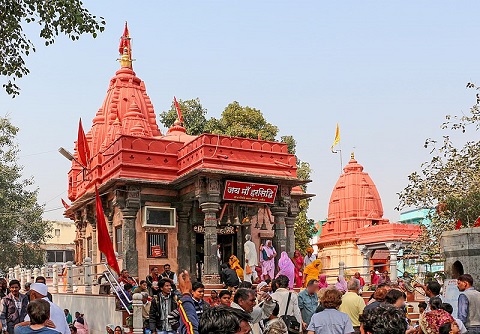While traveling to temple city Ujjain, make it sure not to miss Harsiddhi Mata temple, one of the revered 51 Shakti Peeths in India. The temple is situated barely 500 meters from the Mahakala Jyotirlinga shrine and you can easily walk the distance to visit this very famous temple of Ujjain. The temple holds a special place in the galaxy of Ujjain’s ancient sacred sites.
This holy Peeth, which also houses three other temples, one of which is dedicated to Karkoteshwar Mahadev, is located near the very popular Ram Ghat in a north-easterly direction from Shri Mahakaleshwar Temple. The Marathas built the two towering Lamp Pillars, which are an attractive feature of the temple. The evening Arati held here will leave you spellbound.
As you walk from Mahakaleeshwar temple to this temple you also come across Vikramaditya Teela en route, another iconic attraction in Ujjain. It is always a good practice to visit this temple during the evening aarti time .And I did just that and found this to be the best time to visit the temple. During the evening aarti time the lamps are lit on pillars and it is some kind of a spectacle. A huge crowd gather in the temple premises to witness the evening Aarti, a special feature of Harsiddhi Mata Temple of Ujjain.
In this post I will discuss all that you need to know about this very famous and important shrine before planning a visit to Ujjain.
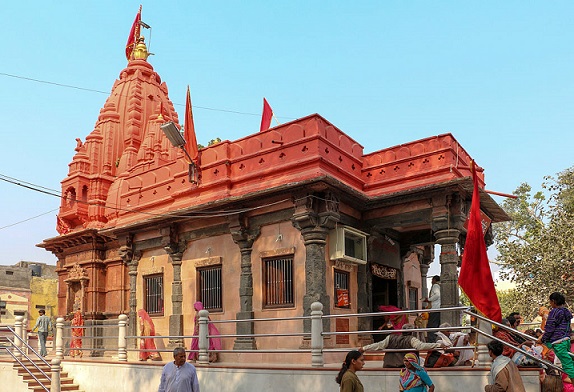
Post Contents
Goddess Harsiddhi in mythology
There are references of Goddess Harsiddhi in the puranic texts of ancient Indian mythological scriptures. According to the Shiva Purana, when Shiva carried Sati’s burning body away from the sacrificial fire, her elbow fell at this site.
The Skanda Purana has a fascinating legend about how the Goddess Chandi came to be known as Harsiddhi. When Shiva and Parvati were alone on Mount Kailash, two demons named Chand and Prachand tried to force their way in. Shiva asked Chandi to destroy them, which she did. Shiva, pleased, bestowed the title “one who vanquishes all” on her which translates to Harsiddhi.
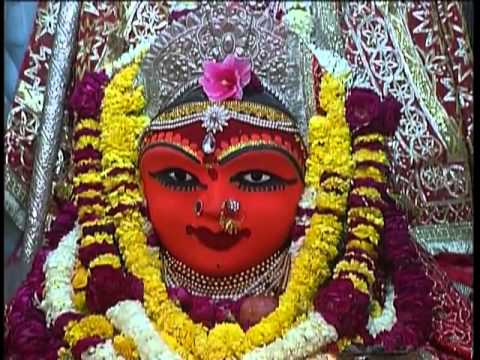
Do Read: Kaal Bhairav Temple of Ujjain: Shrine with the weird tradition of liquor offering
Original seat of Harsiddh
The original temple dedicated to Goddess Harsiddhi Mata is located atop Koyla Dungar hill at Gandhvi village near Porbandar, Gujarat, 40 kilometres from Porbandar and 65 kilometres from Dwarka. It is one of the oldest temples in Gujarat and one of the most popular places to visit en route from Porbandar to Dwarka. The goddess is believed to be one of the aspects of Hindu Devis Amba and Kalika. The original temple atop the hill is said to have been built by Lord Krishna himself.
Legend has it that Lord Krishna prayed to Amba Mata for more power in order to defeat the demon king Jarasandha. Krishna was able to defeat Jarasandha thanks to the goddess’ blessings. Lord Krishna built this temple after his victory in battle and celebrated with his Yadav community. Since then, the Yadav community has been worshiping Harsiddhi Mata as their Kuldevi. She is also revered as Kuldevi by many Kshatriya, Brahmin, Rajput, and Vaishya communities.
Currently, no puja is performed in the original temple, but rather in a temple built in the market around 1300 AD by a Jain merchant named Jagdu Shah. To reach the original temple on Koyla Dungar hill, you need to climb some 300 steps. The temple provides a stunning view of the sea and its surrounding plains. A tranquil beach is also nearby where you can relax.
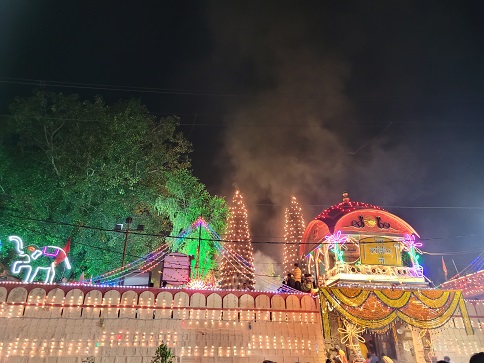
Harsiddhi Temple of Ujjain
The state of Madhya Pradesh has many temples that are endowed with tantric and magical powers. In a few places, King Vikramaditya established temples with magical and tantric powers and offered prayer and worship. One such temple he built is the Goddess Harsiddhi Mata temple in Ujjain, which is also one of India’s 51 major Shakti Peethas. According to legend, when Lord Shiva carried his consort on his shoulders, Goddess Parvati’s elbow fell here.
Harsiddhi Devi temples can be found all over India, particularly in Gujarat and Madhya Pradesh. Three Goddesses are enshrined side by side in the sanctum of the temple in Ujjain. The one on the left is Goddess Maha Saraswati, who is followed by the main deity, Goddess Harsiddhi (who is actually Maha Lakshmi, also known as Goddess Annapoorna) who is slightly larger in size. Goddess Kali is the third in the pedestal. Goddess Harsiddhi Mata is painted in a dark vermillion colour.
Before entering the sanctum, one can see the main hall, which has 51 tantric deities enshrined on the inner roof top, including Sree Yantra, which represents the nine forms of goddess Durga. The presence of Shree Yantra which represents nine forms of Durga is one of the distinguishing features of this temple.
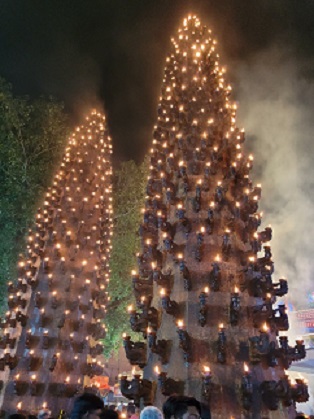
Related Post: Your Ultimate Guide to visit Mahakaleshwar Temple in Ujjain
Harsiddhi Temple Architecture
Though the original temple is believed to have been built by King Vikramaditya, strong Maratha influences can be seen in the temple architecture. This is because the temple has been largely reconstructed during the Maratha era. It has four entrances, one in each direction, with the main entrance on the eastern side. Apart from the temples, the other notable structures in the temple complex include the two towering lamp pillars that are quite eye-catching.
The lamp pillars are built in the traditional medieval Maratha architectural style. The 726 light holders on these two pillars are especially stunning when lit during Navratri (a holy nine-day festival). Apart from these two prominent pillars, there is an ancient well within the grounds with an artistically carved pillar adorning its top.Behind the temple is the ancient Siddha shrine of Agasteshwar, a Mahakaleshwar devotee.

Other temples in Harsidhhi Temple complex
Though there are several other small temples existing within the Harsiddhi Temple Complex in Ujjain, the two which need special mention are the Karkoteswar Mahadev Temple and the Mahamaya Temple. You can visit the Karkoteswar shrine during your visit to Harsiddhi Temple while Mahamaya Temple is closed to the visitors.
Karkoteswar Mahadev Temple
Karkoteswar Mahadev, one of the 84 Mahadevs of Ujjain is enshrined in a small shrine in the Harsiddhi Devi Temple premise. The legend associated with Karkoteshwar acquiring the title Karkoteshwar Mahadev is thus. Following a curse, the serpents began to fall into the pyre of a Yagna performed by Janamejaya and died.
So many of them went to the Himalayas to do penance in order to save themselves. Serpent King Karkotan sought advice from Lord Brahma in order to avoid the wrath of the burning pyre. Lord Brahma advised them to visit the Mahakaleshwar forest in Ujjain and pray to Lord Shiva.
Serpent Karkotan immediately went to Mahakaleshwar forest with other serpents and sat in penance, after which Lord Shiva appeared before him and removed the curse, putting an end to their nightmare. Pleased Lord Shiva advised Serpent King Karkotan to sit in a temple in the name of Karkoteshwar Mahadev and bless the devotees to get rid of the sins accrued from killing serpents by some members of their family even in earlier generations.
As a result, a mini temple in the name of Karkoteshwar Mahadev has been built for Karkotan, in which the Serpent King Karkotan is enshrined with chants of specific mantras relevant to divine serpents. You can see devotees in large numbers visit this revered shrine and some perform puja to get rid of kala sarpa dosha.
Mahamaya Temple
The Goddess Mahamaya housed in a separate sanctum in the Harsiddhi Mata temple complex, is also revered as a powerful deity. Devotees are not permitted to enter her sanctum, which is located below ground level and connected by a narrow passage. Only the priest is permitted to enter the sanctum to perform Pooja for her, and devotees worship her through a grilled window installed on the ground floor.
When offered prayer to her, it is widely assumed that all the ill effects of previous karmas would be removed. An oil lamp kept there has been burning continuously for several years. A small sanctum for Lord Vinayaga is located opposite this sanctum.
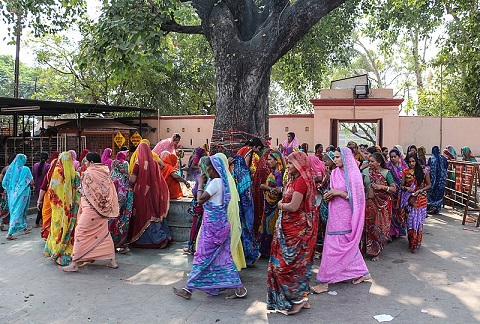
Related Post: Visiting Taratarini Temple, the Adi Shakti Peetha in Odisha
Best Time to Visit
If you prefer a pleasant climate, then October to February are the best months to visit Ujjain. Summer months are quite hot while monsoon season might spoil your party and should be avoided. If you want to see the temple in all its glory, it should be visited during Navratri festivities. Many lamps and candles illuminate this place, illuminating the hearts of the visitors with a sense of mysticism. The twin towers which adorn the temple come alive with the oil lamps creating some kind of a spectacle. It is always a good practice to visit the temple in the evening.
Getting There
The nearest airport to Ujjain for visiting Harsiddhi Mata Mandir is Maharani Ahilya Bai Holkar Airport in Indore. It is located 56 kilometres away from Ujjain. In Ujjain, there are three major railway stations: Ujjain City Junction, Vikram Nagar, and Chintaman (Meter Gauge).
Want to travel to Ujjain by bus or car? Dewas Gate and Nanakheda are the two major bus terminals in Ujjain. There are regular bus services from major cities of MP to Ujjain. You can also take a private vehicle to Harsiddhi shrine in Ujjain.
Fast Facts
Location: Jaisinghpura, Ujjain
Distance from Ujjain Bus Stand: 2.4 kilometres
Timing: Sunrise to Sunset, Depends upon which month you are visiting
Entry Fee: None

